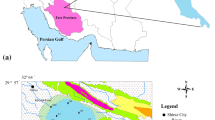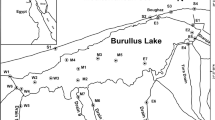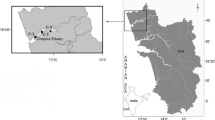Abstract
Metal speciation can provide sufficient information for environmental and geochemical researches. In this study, based on the speciation determination of Cu and Zn in the Yangtze Estuary sediments, roles of eight geochemical controls (i.e., total organic carbon (TOC), clay, Fe/Mn in five chemical fractions and salinity) are fully investigated and sequenced with correlation analysis (CA) and principal components analysis (PCA). Results show that TOC, clay and Fe/Mn oxides are key geochemical factors affecting the chemical speciation distributions of Cu and Zn in sediments, while the role of salinity appears to be more indirect effect. The influencing sequence generally follows the order: TOC> clay>Mn oxides>Fe oxides>salinity. Among the different fractions of Fe/Mn oxides, residual and total Fe content, and exchangeable and carbonate Mn exert the greatest influences, while exchangeable Fe and residual Mn show the poorest influences.
Similar content being viewed by others
References
Wang Z L, Liu C Q. Distribution and partition behavior of heavy metals between dissolved and acid-soluble fractions along a salinity gradient in the Changjiang Estuary, eastern China. Chemical Geology, 2003, 202(3–4): 383–396
Filgueiras A V, Lavilla I, Bendicho C. Evaluation of distribution, mobility and binding behaviour of heavy metals in surficial sediments of Louro River (Galicia, Spain) using chemometric analysis: a case study. Science of the Total Environment, 2004, 330(1–3): 115–129
Eggleton J, Thomas K V. A review of factors affecting the release and bioavailability of contaminants during sediment disturbance events. Environment International, 2004, 30(7): 973–980
Beck M, Böning P, Schückel U, Stiehl T, Schnetger B, Rullkötter J, Brumsack H J. Consistent assessment of trace metal contamination in surface sediments and suspended particulate matter: a case study from the Jade Bay in NW Germany. Marine Pollution Bulletin, 2013, 70(1–2): 100–111
Liu B, Hu K, Jiang Z, Yang J, Luo X, Liu A. Distribution and enrichment of heavy metals in a sediment core from the Pearl River Estuary. Environmental Earth Sciences, 2011, 62(2): 265–275
Sander S G, Hunter K A, Harms H, Wells M. Numerical approach to speciation and estimation of parameters used in modeling trace metal bioavailability. Environmental Science & Technology, 2011, 45(15): 6388–6395
Yang Z, Wang Y, Shen Z, Niu J, Tang Z. Distribution and speciation of heavy metals in sediments from the mainstream, tributaries, and lakes of the Yangtze River catchment of Wuhan, China. Journal of Hazardous Materials, 2009, 166(2–3): 1186–1194
Passosa E, Alves J, Santos I, Alves J, Garcia C, Costa A. Assessment of trace metals contamination in estuarine sediments using a sequential extraction technique and principal component analysis. Microchemical Journal, 2010, 96(1): 50–57
Chakraborty P, Babu P V, Sarma V V. A study of lead and cadmium speciation in some estuarine and coastal sediments. Chemical Geology, 2012, 294: 217–225
Zhao X, Dong D, Hua X, Dong S. Investigation of the transport and fate of Pb, Cd, Cr(VI) and As(V) in soil zones derived from moderately contaminated farmland in Northeast, China. Journal of Hazardous Materials, 2009, 170(2–3): 570–577
Tessier A, Campbell P G C, Bisson M. Sequential extraction procedure for the speciation of particulate trace metals. Analytical Chemistry, 1979, 51(7): 844–851
Wen L S, Warnken K W, Santschi P H. The role of organic carbon, iron, and aluminium oxyhydroxides as trace metal carriers: Comparison between the Trinity River and the Trinity River Estuary (Galveston Bay, Texas). Marine Chemistry, 2008, 112(1): 20–37
Dai Y, Yin L, Niu J. Laccase-carrying electrospun fibrous membranes for adsorption and degradation of PAHs in shoal soils. Environmental Science & Technology, 2011, 45(24): 10611–10618
Zhao S, Feng C, Huang X, Li B, Niu J, Shen Z. Role of uniform pore structure and high positive charges in the arsenate adsorption performance of Al13-modified montmorillonite. Journal of Hazardous Materials, 2012, 203–204: 317–325
Owojori O J, Reinecke A J, Rozanov A B. Role of clay content in partitioning, uptake and toxicity of zinc in the earthworm Eisenia fetida. Ecotoxicology and Environmental Safety, 2009, 72(1): 99–107
Garnier J M, Guieu C. Release of cadmium in the Danube estuary: contribution of physical and chemical processes as determined by an experimental approach. Marine Environmental Research, 2003, 55(1): 5–25
Calmano W, Hong J, Förstner U. Binding and mobilization of heavy metals in contaminated sediments affected by pH and redox potential. Water Science and Technology, 1993, 28(8): 223–235
Du Laing G, Rinklebe J, Vandecasteele B, Meers E, Tack FM. Trace metal behaviour in estuarine and riverine floodplain soils and sediments: a review. Science of the Total Environment, 2009, 407(13): 3972–3985
Förstner U, Ahlf W, Calmano W. Studies on the transfer of heavy metals between sedimentary phases with a multi-chamber device: combined effects of salinity and redox variation. Marine Chemistry, 1989, 28(1): 145–158
Acosta J A, Jansen B, Kalbitz K, Faz A, Martínez-Martínez S. Salinity increases mobility of heavy metals in soils. Chemosphere, 2011, 85(8): 1318–1324
Zhao S, Feng C, Wang D, Liu Y, Shen Z. Salinity increases the mobility of Cd, Cu, Mn, and Pb in the sediments of Yangtze Estuary: relative role of sediments’ properties and metal speciation. Chemosphere, 2013, 91(7): 977–984
Wong V, Johnston S, Burton E, Bush R, Sullivan L, Slavich P. Seawater causes rapid trace metal mobilisation in coastal lowland acid sulfate soils: Implications of sea level rise for water quality. Geoderma, 2010, 160(2): 252–263
Saito Y, Yang Z, Hori K. The Huanghe (Yellow River) and Changjiang (Yangtze River) deltas: a review on their characteristics, evolution and sediment discharge during the Holocene. Geomorphology, 2001, 41(2): 219–231
Li B, Feng C, Li X, Chen Y, Niu J, Shen Z. Spatial distribution and source apportionment of PAHs in surficial sediments of the Yangtze Estuary, China. Marine Pollution Bulletin, 2012, 64(3): 636–643
Elzinga E J, Cirmo A. Application of sequential extractions and Xray absorption spectroscopy to determine the speciation of chromium in Northern New Jersey marsh soils developed in chromite ore processing residue (COPR). Journal of Hazardous Materials, 2010, 183(1–3): 145–154
Giacomino A, Malandrino M, Abollino O, Velayutham M, Chinnathangavel T, Mentasti E. An approach for arsenic in a contaminated soil: speciation, fractionation, extraction and effluent decontamination. Environmental Pollution, 2010, 158(2): 416–423
Shao M, Zhang T, Fang H H. Autotrophic denitrification and its effect on metal speciation during marine sediment remediation. Water Research, 2009, 43(12): 2961–2968
Naji A, Ismail A, Ismail A R. Chemical speciation and contamination assessment of Zn and Cd by sequential extraction in surface sediment of Klang River, Malaysia. Microchemical Journal, 2010, 95(2): 285–292
Su D C, Wong J W C. Chemical speciation and phytoavailability of Zn, Cu, Ni and Cd in soil amended with fly ash-stabilized sewage sludge. Environment International, 2004, 29(7): 895–900
Banerjee A D K. Heavy metal levels and solid phase speciation in street dusts of Delhi, India. Environmental Pollution, 2003, 123(1): 95–105
Sundaray S K, Nayak B B, Lin S, Bhatta D. Geochemical speciation and risk assessment of heavy metals in the river estuarine sediments-a case study: Mahanadi basin, India. Journal of Hazardous Materials, 2011, 186(2–3): 1837–1846
Chao T T. Use of partial dissolution techniques in geochemical exploration. Journal of Geochemical Exploration, 1984, 20(2): 101–135
Wang X, Li Y. Measurement of Cu and Zn adsorption onto surficial sediment components: new evidence for less importance of clay minerals. Journal of Hazardous Materials, 2011, 189(3): 719–723
Plach J M, Elliott A V C, Droppo I G, Warren L A. Physical and ecological controls on freshwater floc trace metal dynamics. Environmental Science & Technology, 2011, 45(6): 2157–2164
Rath P, Panda U C, Bhatta D, Sahu K C. Use of sequential leaching, mineralogy, morphology and multivariate statistical technique for quantifying metal pollution in highly polluted aquatic sediments-a case study: Brahmani and Nandira Rivers, India. Journal of Hazardous Materials, 2009, 163(2–3): 632–644
Goh B P L, Chou L M. Heavy metal levels in marine sediments of Singapore. Environmental Monitoring and Assessment, 1997, 44(1–3): 67–80
Turner A. Marine pollution from antifouling paint particles. Marine Pollution Bulletin, 2010, 60(2): 159–171
Xian X. Effect of chemical forms of cadmium, zinc, and lead in polluted soils on their uptake by cabbage plants. Plant and Soil, 1989, 113(2): 257–264
Yuan C G, Shi J B, He B, Liu J F, Liang L N, Jiang G B. Speciation of heavy metals in marine sediments from the East China Sea by ICP-MS with sequential extraction. Environment International, 2004, 30(6): 769–783
Li Q, Wu Z, Chu B, Zhang N, Cai S, Fang J. Heavy metals in coastal wetland sediments of the Pearl River Estuary, China. Environmental Pollution, 2007, 149(2): 158–164
Sundaray S K, Nayak B B, Lin S, Bhatta D. Geochemical speciation and risk assessment of heavy metals in the river estuarine sediments-a case study: Mahanadi basin, India. Journal of Hazardous Materials, 2011, 186(2–3): 1837–1846
Lasheen M R, Ammar N S. Speciation of some heavy metals in River Nile sediments, Cairo, Egypt. Environmentalist, 2009, 29(1): 8–16
Nordmyr L, Österholm P, Aström M. Estuarine behaviour of metal loads leached from coastal lowland acid sulphate soils. Marine Environmental Research, 2008, 66(3): 378–393
Turner A. Trace metal contamination in sediments from UK estuaries: an empirical evaluation of the role of hydrous iron and manganese oxides. Estuarine, Coastal and Shelf Science, 2000, 50(3): 355–371
Author information
Authors and Affiliations
Corresponding author
Rights and permissions
About this article
Cite this article
Zhao, S., Wang, D., Feng, C. et al. Sequence of the main geochemical controls on the Cu and Zn fractions in the Yangtze River estuarine sediments. Front. Environ. Sci. Eng. 10, 19–27 (2016). https://doi.org/10.1007/s11783-014-0723-4
Received:
Accepted:
Published:
Issue Date:
DOI: https://doi.org/10.1007/s11783-014-0723-4




